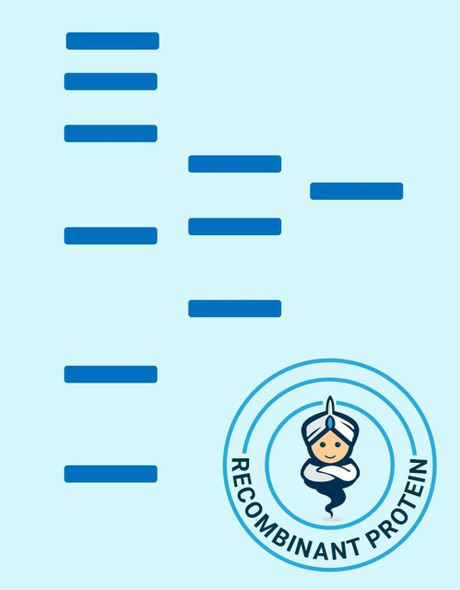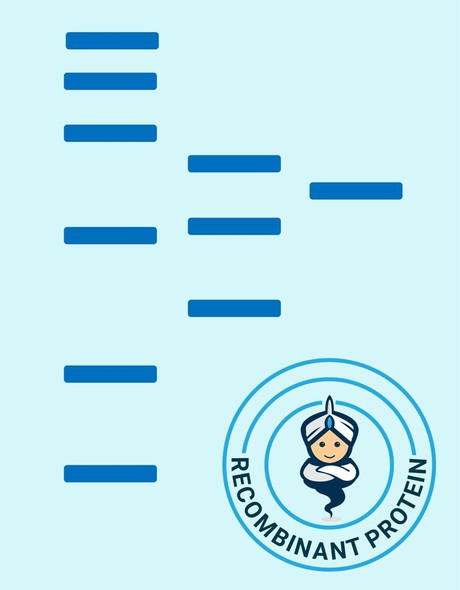Neurotrophins Recombinant Proteins
Human ProNGF Recombinant Protein (RPPB0112)
- SKU:
- RPPB0112
- Product Type:
- Recombinant Protein
- Species:
- Human
- Uniprot:
- P01138
- Research Area:
- Neurotrophins
Description
| Product Name: | Human ProNGF Recombinant Protein |
| Product Code: | RPPB0112 |
| Size: | 10µg |
| Species: | Human |
| Target: | ProNGF |
| Synonyms: | Human Pro-NGF, ProNGF, NGFB. |
| Source: | Escherichia Coli |
| Physical Appearance: | Sterile Filtered White lyophilized (freeze-dried) powder. |
| Formulation: | ProNGF was lyophilized from a 0.2 �M filtered solution of 20mM PB and 250mM NaCl pH 7.2. |
| Solubility: | It is recommended to reconstitute the lyophilized ProNGF in 1xPBS to a concentration no less than 100 �g/ml, which can then be further diluted to other aqueous solutions. |
| Stability: | Lyophilized ProNGF although stable at room temperature for 3 weeks, should be stored desiccated below -18°C. Upon reconstitution ProNGF should be stored at 4°C between 2-7 days and for future use below -18°C. Please prevent freeze-thaw cycles. |
| Purity: | Greater than 95.0% as determined by SDS-PAGE. |
| Amino Acid Sequence: | MEPHSESNVPAGHTIPQAHWTKLQHSLDTALRRARSAPAAAIAARVAGQTRNITVDPRLFKKRRLRSPRVLFSTQPPREAADTQDLDFEVGGAAPFNRTHRSKRSSSHPIFHRGEFSVCDSVSVWVGDKTTATDIKGKEVMVLGEVNINNSVFKQYFFETKCRDPNPVDSGCRGIDSKHWNSYCTTTHTFVKALTMDGKQAAWRFIRIDTACVCVLSRKAVRRA |
Pro NGF is the pro-form of the neurotrophin nerve growth factor. Like the mature protein pro NGF is characterized by the cysteine knot motif consisting of three cysteine bridges. The protein predominantly exists as a non-covalently linked homodimer.Pro-Nerve Growth Factor Human Recombinant produced in E.Coli is a non-glycosylated, polypeptide chain containing 224 amino acids and having a molecular mass of 50KDa.The Pro NGF is purified by proprietary chromatographic techniques.
| UniProt Protein Function: | NGF: Nerve growth factor is important for the development and maintenance of the sympathetic and sensory nervous systems. Extracellular ligand for the NTRK1 and NGFR receptors, activates cellular signaling cascades through those receptor tyrosine kinase to regulate neuronal proliferation, differentiation and survival. Homodimer. Belongs to the NGF-beta family. |
| UniProt Protein Details: | Protein type:Secreted, signal peptide; Secreted Chromosomal Location of Human Ortholog: 1p13.1 Cellular Component: cytoplasmic membrane-bound vesicle; endosome; extracellular region; Golgi lumen Molecular Function:growth factor activity; metalloendopeptidase inhibitor activity; nerve growth factor receptor binding; protein binding; receptor signaling protein activity Biological Process: activation of MAPKK activity; cell-cell signaling; induction of apoptosis via death domain receptors; negative regulation of apoptosis; negative regulation of cell cycle; negative regulation of neuron apoptosis; nerve growth factor processing; nerve growth factor receptor signaling pathway; neurite morphogenesis; neuron apoptosis; peripheral nervous system development; phosphoinositide-mediated signaling; phospholipase C activation; positive regulation of apoptosis; positive regulation of axon extension; positive regulation of axonogenesis; positive regulation of collateral sprouting; positive regulation of neuron maturation; positive regulation of protein ubiquitination; Ras protein signal transduction; regulation of axonogenesis; regulation of caspase activity; regulation of neuron differentiation; regulation of neurotransmitter secretion; regulation of release of sequestered calcium ion into cytosol; sensory perception of pain; small GTPase mediated signal transduction; transmembrane receptor protein tyrosine kinase signaling pathway Disease: Neuropathy, Hereditary Sensory And Autonomic, Type V |
| NCBI Summary: | This gene is a member of the NGF-beta family and encodes a secreted protein which homodimerizes and is incorporated into a larger complex. This protein has nerve growth stimulating activity and the complex is involved in the regulation of growth and the differentiation of sympathetic and certain sensory neurons. Mutations in this gene have been associated with hereditary sensory and autonomic neuropathy, type 5 (HSAN5), and dysregulation of this gene's expression is associated with allergic rhinitis. [provided by RefSeq, Jul 2008] |
| UniProt Code: | P01138 |
| NCBI GenInfo Identifier: | 90110037 |
| NCBI Gene ID: | 4803 |
| NCBI Accession: | P01138.3 |
| UniProt Secondary Accession: | P01138,Q6FHA0, Q96P60, Q9P2Q8, Q9UKL8, A1A4E5, |
| UniProt Related Accession: | P01138 |
| Molecular Weight: | 26,959 Da |
| NCBI Full Name: | Beta-nerve growth factor |
| NCBI Synonym Full Names: | nerve growth factor |
| NCBI Official Symbol: | NGF�� |
| NCBI Official Synonym Symbols: | NGFB; HSAN5; Beta-NGF�� |
| NCBI Protein Information: | beta-nerve growth factor |
| UniProt Protein Name: | Beta-nerve growth factor |
| Protein Family: | Nerve growth factor |
| UniProt Gene Name: | NGF�� |
| UniProt Entry Name: | NGF_HUMAN |






